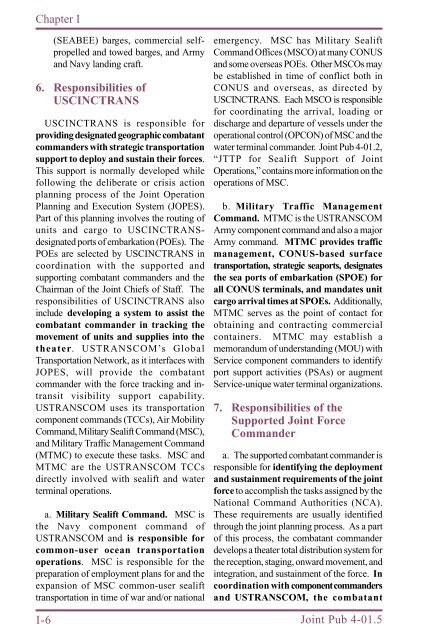JP 4-01.5 JTTP for Water Terminal Operations - BITS
JP 4-01.5 JTTP for Water Terminal Operations - BITS
JP 4-01.5 JTTP for Water Terminal Operations - BITS
Create successful ePaper yourself
Turn your PDF publications into a flip-book with our unique Google optimized e-Paper software.
Chapter I<br />
I-6<br />
(SEABEE) barges, commercial selfpropelled<br />
and towed barges, and Army<br />
and Navy landing craft.<br />
6. Responsibilities of<br />
USCINCTRANS<br />
USCINCTRANS is responsible <strong>for</strong><br />
providing designated geographic combatant<br />
commanders with strategic transportation<br />
support to deploy and sustain their <strong>for</strong>ces.<br />
This support is normally developed while<br />
following the deliberate or crisis action<br />
planning process of the Joint Operation<br />
Planning and Execution System (JOPES).<br />
Part of this planning involves the routing of<br />
units and cargo to USCINCTRANSdesignated<br />
ports of embarkation (POEs). The<br />
POEs are selected by USCINCTRANS in<br />
coordination with the supported and<br />
supporting combatant commanders and the<br />
Chairman of the Joint Chiefs of Staff. The<br />
responsibilities of USCINCTRANS also<br />
include developing a system to assist the<br />
combatant commander in tracking the<br />
movement of units and supplies into the<br />
theater. USTRANSCOM’s Global<br />
Transportation Network, as it interfaces with<br />
JOPES, will provide the combatant<br />
commander with the <strong>for</strong>ce tracking and intransit<br />
visibility support capability.<br />
USTRANSCOM uses its transportation<br />
component commands (TCCs), Air Mobility<br />
Command, Military Sealift Command (MSC),<br />
and Military Traffic Management Command<br />
(MTMC) to execute these tasks. MSC and<br />
MTMC are the USTRANSCOM TCCs<br />
directly involved with sealift and water<br />
terminal operations.<br />
a. Military Sealift Command. MSC is<br />
the Navy component command of<br />
USTRANSCOM and is responsible <strong>for</strong><br />
common-user ocean transportation<br />
operations. MSC is responsible <strong>for</strong> the<br />
preparation of employment plans <strong>for</strong> and the<br />
expansion of MSC common-user sealift<br />
transportation in time of war and/or national<br />
emergency. MSC has Military Sealift<br />
Command Offices (MSCO) at many CONUS<br />
and some overseas POEs. Other MSCOs may<br />
be established in time of conflict both in<br />
CONUS and overseas, as directed by<br />
USCINCTRANS. Each MSCO is responsible<br />
<strong>for</strong> coordinating the arrival, loading or<br />
discharge and departure of vessels under the<br />
operational control (OPCON) of MSC and the<br />
water terminal commander. Joint Pub 4-01.2,<br />
“<strong>JTTP</strong> <strong>for</strong> Sealift Support of Joint<br />
<strong>Operations</strong>,” contains more in<strong>for</strong>mation on the<br />
operations of MSC.<br />
b. Military Traffic Management<br />
Command. MTMC is the USTRANSCOM<br />
Army component command and also a major<br />
Army command. MTMC provides traffic<br />
management, CONUS-based surface<br />
transportation, strategic seaports, designates<br />
the sea ports of embarkation (SPOE) <strong>for</strong><br />
all CONUS terminals, and mandates unit<br />
cargo arrival times at SPOEs. Additionally,<br />
MTMC serves as the point of contact <strong>for</strong><br />
obtaining and contracting commercial<br />
containers. MTMC may establish a<br />
memorandum of understanding (MOU) with<br />
Service component commanders to identify<br />
port support activities (PSAs) or augment<br />
Service-unique water terminal organizations.<br />
7. Responsibilities of the<br />
Supported Joint Force<br />
Commander<br />
a. The supported combatant commander is<br />
responsible <strong>for</strong> identifying the deployment<br />
and sustainment requirements of the joint<br />
<strong>for</strong>ce to accomplish the tasks assigned by the<br />
National Command Authorities (NCA).<br />
These requirements are usually identified<br />
through the joint planning process. As a part<br />
of this process, the combatant commander<br />
develops a theater total distribution system <strong>for</strong><br />
the reception, staging, onward movement, and<br />
integration, and sustainment of the <strong>for</strong>ce. In<br />
coordination with component commanders<br />
and USTRANSCOM, the combatant<br />
Joint Pub 4-<strong>01.5</strong>
















